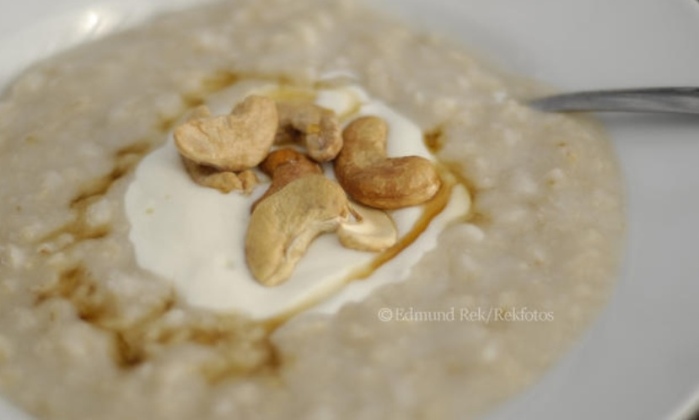
Cooked cereal grains have been a staple throughout civilization and “provide more food energy worldwide than any other crop.” As whole grains, they provide more vitamins, minerals and protein than their refined counterparts. (After removal of the bran and germ where mostly carbohydrates are left behind.) Ancient farming communities from areas in and around Egypt and Iraq first domesticated emmeri wheat, einkorn wheat and barley.
Beyond west Asia there are several important staple cereal grains grown worldwide: maize (Americas, Africa), rice (tropical, temperate regions), sorghum (Asia, Africa), millet (Asia, Africa), oats (worldwide), rye (colder climates), fonio (Africa), buckwheat Europe, Asia), quinoa (Andes).
Closer to home, our three favorite cereals are congee, museli (hot or cold) and polenta.
Congee is eaten all over eastern Asia, mostly for breakfast, or a late supper. A little rice and a lot if water (about 1:10 ratio) are cooked together to a porridge consistency. It’s personality is in the accompaniments: grilled pork, egg, chili, scallions, cilantro, you name it! It’s a blank canvas of any flavor inspiration.
Birchemuesli, or muesli, is a popular Swiss German breakfast cereal and late night snack. Renouned for being healthy it originally was prepared for recoverying hospital patients. Full of oat flakes (sometimes wheat, or rye), seeds, nuts and fruit it is often soaked ahead of time in water, cream or yogurt. We have been making our own version of “muse-li” and eat it as a hot cereal. A great way to start the day as the chill of winter is upon us. (About 1:4 cereal to water; cooked until thickens and grains are tender; serve with sheep’s yogurt, cinnamon (copious amounts), our granola and maple syrup).
Polenta: one of the three holy “P’s” behind pizza and pasta is not always considered a cereal. More often, this creamy, starchy, once Roman staple is cooked with seasoned stock, cream, milk, or water and paired with sauces, meats and vegetables. You can add less liquid and slice and grill the polenta after it cools and becomes firm. We use organic stone ground corn from Stoddarts Farm that has both coarse and fine grain mixed in (and it actually smells like corn!). The liquid base is 1/2 stock and 1/2 milk with bay leaf, salt and touch of cayenne pepper, plenty of garlic cooked in butter and a lot of grated cheese stirred in at the end. (I mentioned stir.) The best polenta is stirred constantly throughout cooking to prevent scorching and splatter as it thickens. (1:5 ratio cornmeal to liquid for creamy; 1:4 for firm; cook until thickens and the grains are tender; Buckwheat can be substituted or added with the cornmeal.)
Many whole cereal grains are available to us can easily be added to our diet. Freshly milled ones have a obvious benefits of more flavor and can be healthier for you. Try and buy from the source. A local farming community (or farmers market) is a great place to look. Although often more variety, keep in mind store bought ones will have gone through a distributor and may have been warehoused for some time.